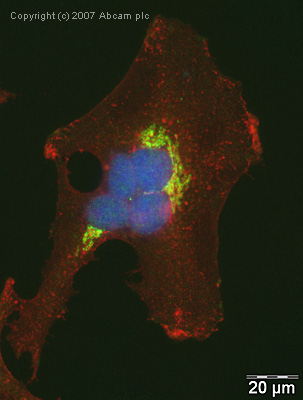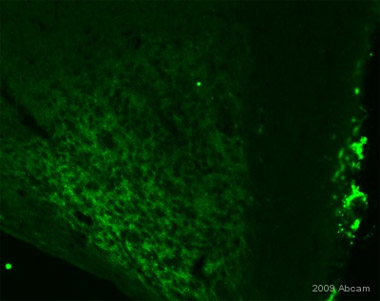
All lanes : Anti-Neuroglycan C antibody (ab31946) at 1 µg/mlLane 1 : Mouse Spinal Cord LysateLane 2 : Rat Spinal Cord LysateLysates/proteins at 20 µg per lane.SecondaryIRDye 680 Conjugated Goat Anti-Rabbit IgG (H+L) at 1/15000 dilutionPerformed under reducing conditions.

All lanes : Anti-Neuroglycan C antibody (ab31946) at 1 µg/mlLane 1 : Brain (Mouse) Tissue Lysate Lane 2 : Brain (Rat) Tissue Lysate - normal tissueLysates/proteins at 10 µg per lane.SecondaryIRDye 680 Conjugated Goat Anti-Rabbit IgG (H+L) at 1/10000 dilutionPerformed under reducing conditions.

ICC/IF image of ab31946 stained human HeLa cells. The cells were methanol fixed (5 min), permabilised in TBS-T (20 min) and incubated with the antibody (ab31946, 1µg/ml) for 1h at room temperature. 1%BSA / 10% normal goat serum / 0.3M glycine was used to quench autofluorescence and block non-specific protein-protein interactions. The secondary antibody (green) was Alexa Fluor® 488 goat anti-rabbit IgG (H+L) used at a 1/1000 dilution for 1h. Alexa Fluor® 594 WGA was used to label plasma membranes (red). DAPI was used to stain the cell nuclei (blue).

ab31946 staining Neuroglycan C in rat brain tissue section by Immunohistochemistry (PFA perfusion fixed frozen sections). Tissue from 4% PFA perfused animals underwent overnight fixation in 4% paraformaldehyde, cryoprotected in 30% sucrose and cut using cryostat.The primary antibody was diluted, 1/300 (PBS + 0.3% Triton X100) and incubated with sample for 18 hours at 20°C. An Alexa Fluor® 488 conjugated goat polyclonal to rabbit IgG was used at 1/1000 dilution, as secondary.This image is courtesy of an Abreview submitted by Dr Sophie Pezet.



